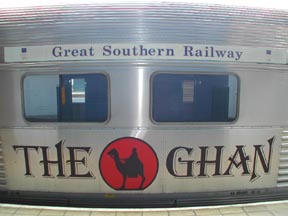
|

|
LINKS FOR THE YEAR 2002 |
| [JAN] [FEB] [MARCH] [APRIL] [MAY] [JUNE] [JULY] [AUG] [SEPT] [OCT] [NOV] [DEC] |
Archives [Intro] [2000] [2001] [2003] |
|
Log for the week of March 3, 2002 Coff's Harbour NSW by PS This weeks highlight was an encounter with one of the most deadly snakes in Australia. It all started innocently enough by bending to Amy's desire to go on an overnight camping trip. We headed out on Wednesday to the "bush", which Amy decided was about a 3-hour drive to the west. On our way out of Coff's Harbour, we stopped at a barbecue store to buy some sleeping pads. You read correctly, a barbecue store. Now it's been our experience that if you can find what you are looking for in a place totally unrelated to the item, you can save money. This is how we try and do our shopping. It does have its limits though. Grocery stores are still the best place to buy groceries. She came out of the store with two camping pads about one half inch thick and a thick cushion from a picnic bench. She said the thick pad was for me, as she didn't want to see me suffer from sharp-rock-in-back-itis. 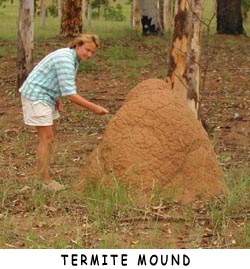
We drove north to Grafton, then headed west into the "bush' on a gradually narrowing road. It eventually became a one-lane dirt "track", which got exciting when you encountered the occasional logging truck heading the other way. I had all I could do to keep from pulling over to the American side of the road. Oncoming cars, swerving to their respective countries side of the road, equal trouble. Up until this point, the only "roo" we saw was back on the main highway. I guess I expected to be dodging them left and right in the bush. Kind of like those PBS nature shows you see on TV. We saw some termite mounds and a few birds, but the rest of the wildlife seemed to be hiding. The road started following a small river with some inviting flat ground to camp on. We headed down the first road leading to the rivers edge. Doh! There were two trailer campers parked, with their barbecues going and the TV antennas up. We head back to the "track" looking for a quieter spot. 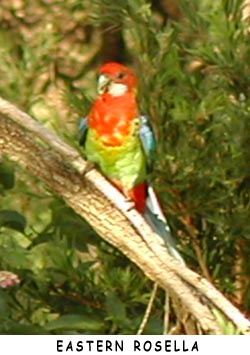
About sunset we found a rather steep rocky road down to the river. Neville made it down, but I hadn't fully considered getting back up until I was at the bottom. Hmmmm. We parked the car on a flat patch of grass and walked back to the steep rocky road. I figured that by moving a few rocks and not stopping halfway up, we just might make it. There seemed to be a 4-wheel track beyond where we stopped, so we decided to do some scouting. After all, there might have been people camping just around the bend. We donned our rubber sea boots, as bush hiking footwear, and headed out. The trail continued on for a few hundred meters with no one in site. By the looks of the hoof marks left by the wild cattle, there hadn't been any cars this way for quite some time. Oh yes, I forgot to mention the "other wildlife". Most of the cattle were Brahma's and some had horns that I didn't want to see close up. I have a healthy respect for large animals with relatively small brains and horns on their heads. We decided to get Neville and move camp a little further up the river. As we headed back, a three-foot black and red snake crossed the track a few feet in front of us. He stopped. We stopped. He raised his head a bit and started to flare out his cheeks like a cobra. Not good. We stared each other down for what seemed like way too long. Mind you, normally I am not afraid of snakes. I was about 12 years old when I brought my first snake home. She lived (I know it was a she, because my mother ended up catching baby snakes off the living room floor before our cat got them) in a large glass candy display case, along with my 3 foot iguana. Anyway, this was not what I was hoping for in a "wildlife" encounter. I was thinking more along the lines of a cuddly koala or a friendly roo with a cute Joey. My mind began to calculate just how oversized my rubber boot was and how long the fangs were on this snake. About that time the snake lost interest and slithered off into the grass. Amy and I continued our walk back to Neville; eyes keen to the ground. And I thought I had horned cattle to worry about... We pitched the tent about 50 meters from the snake sighting, with me hoping he would continue heading to the next county. It was certainly nice to get away from the marina. Our Swiss army surplus stove worked great heating our "Dinty Moore" beef stew and I did manage to get some pictures of birds that surrounded our campsite. It rained for most of the night, but we kept dry in our nylon shelter. It did have an annoying habit of unzipping itself. I kept waking up, checking and re-checking the zippers. I had visions of a snake nosing along looking for a way in out of the rain. 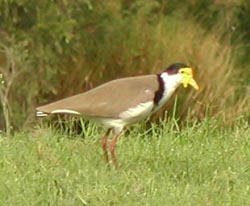
About midnight I heard a faint sound like fabric ripping. Within seconds it turned into a roar that was deafening. Amy sat bolt upright and said," What was that?" I knew immediately what it was, because I had heard the same sound years ago. While attempting to "escape" from civilization in the 1970's, I bought some land in rural Maine and built a log cabin. It was here that I hoped to come to terms with the modern world. No electricity, no running water, miles from my nearest neighbor. The perfect place to fly low level, high speed military aircraft and not endanger anyone. Doh! I had checked out a lot of things before I paid for the land, but I didn't check the aeronautical chart of the area. If I had, I would have noticed a military route that went directly over the cabin. It was along this route that pilots flew as low as they dared, training to avoid enemy radar. Trust me when I say that these pilots took their job seriously. Especially at 2 am. I told Amy to expect another plane to fly over any minute. These guys like to fly with a buddy. Sure enough, two minutes later the second one flew over our tent at tree top level. So much for the wilderness experience. We were lucky though; there were no other flights that night. 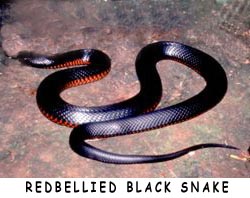
When we returned to Iwalani, Amy did some research about the snake we had seen. It was a Red Bellied Black snake. They live near rivers and don't mind swimming for a meal of frogs. It turns out that it's not as deadly as once thought. Instead of killing you in 30 seconds, they have discovered that it takes more like 10 minutes. Comforting thought. Of course, I didn't have the camera to get a picture of "our" snake, so this canned shot will have to suffice. Needless to say, we will be keeping our eyes to the ground on future trips to the bush. PS
Log for the week of March 10, 2002 New South Wales by VCW Hi there- all you readers of worldvoyagers.com. Guess what! This week you have a guest reporter writing in place of APW. First thing I'm delighted to report to all relatives and friends, we found the sailors to be fit, happy and tanned- and in tune with the world as they found it. May this continue. However, Stewart, the sea going kitty seems arthritic and aging, but keeping a stiff upper lip as he travels along with them. Lets give him three cheers too, and keep our fingers crossed 'til they all are back in Maine. Starting Saturday March 2nd from the East Coast of the United States, we flew to Los Angeles, spent the night and on Sunday visited the fabulous Getty center. A conglomeration of travertine marble, glass and chrome buildings house the huge Getty collection and is clustered at the top of the hill with views of downtown L.A. and the shining Pacific which we were soon to cross. Australia is fierce about new arrivals, as you may have read in previous logs. Once landed, we had a slight altercation with the quarantine guys when we had to declare all edibles, in this case a can of unopened Old Bay seasoning ordered by the main chef aboard Iwalani. It was finally dismissed, but not without a lot of clucking and tsk-tsking. But I don't regret any of this, even when they ordered my dear old partner to open his suitcase where his old sneakers were carefully examined for hoof and mouth disease. They don't want it anymore than we do, after all. The Grace Hotel was to be our abode for the first two nights. Kind of an old fashioned downtown hostelry but with divinely soft beds into which we gratefully fell after having a good dinner a short walk away at the top of the revolving Sydney tower where all of the city was laid out before us. Be sure and go to the sit-down place, we heard the buffet was not so good. After breakfast we did a bit of shopping, a good book store up the street with all the best sellers as well as an interesting section featuring Australian women writers that, of course intrigued me. It was quite warm as we walked along and the fact that that the further north one goes in this place the warmer it gets; drivers do the British thing on the left that is; everything is in Celsius, kilometers and 24 hr. time all takes getting used to. Somehow this seemed to have been made easier for A&P by the slower method of travel or maybe it's just my non-figuring out brain advanced by age. 
From just a cursory standpoint Australians seem to look a lot like us Americans. During World War II there was great mutual admiration when we fought side by side. The young people are dressed in similar fashion, lots of skin showing- girls dressed in what looks like underwear, boys with lots of pierced body parts- eyebrows, noses, tongues etc and colored and spiked hair. But where are our contemporaries? Don't they bring their grandchildren to museums or visit the city? Even at the opera where we heard and saw an excellently sung and staged Fidelio, there were only one or two older parties spotted. Maybe there, at that fantastic building, it is impossible to come as a senior; there are thousands of stairs and only one "lift" in evidence. Everyone else however, seems fit and healthy. Older folk should be helped with things like lifts, railings, ramps on walks and elsewhere. Don't knock it Aussies! For you, too, will eventually reach wise old age! We walked along the waterfront at Circular Quay and watched an aboriginal troupe dance and play the didgeridoo and after a fine harbor cruise the next day we left for the "bush" in the Blue Mountains. In our terms we would say "up country". According to one source, rural areas are experiencing a boom. In New South Wales where we are at present wool, grain, grapes for wine and beef are grown. The market for these products is especially solid in China. But a prolonged drought could and has ruined good times for farmers so some of the farms have been turned into rural retreats just like the one we were headed to the next night. The first thing that caught my eye was the marketing aimed at romance for younger couples. Didn't say anything suggesting that Grandma and Grandpa might enjoy a peaceful night or two away in a bubbly spa. Amy organized a kangaroo camera hunt to take the place when it began to get dark. First we walked up the hill behind our attractive, well supplied and comfortable cabins to a field where the 'roos were supposed to appear. Nary a one, so we piled into faithful Neville and toured the dusty back roads looking for them. Phil finally spotted one down the hill in a kind of a copse of eucalyptus trees but it was sure hard for me to tell whether it was kangaroo or cow. We came back to the cabin for a splendid steak dinner bought and cooked by Amy and once again fell gratefully into bed. We woke to a gray, drizzly day and this day was to be a tour of Sydney Botanical gardens for cool climate plants at Mount Tomah. Rain prevented thorough inspection but we toured in an open sided vehicle and saw many familiars- evergreens, rhodies, azaleas etc but there was one tree growing there that had the botanical world in a tizzy as it had been discovered somewhere in a remote valley. It looked like our tamarack or deciduous pine tree. 
That night we spent in art deco splendor at the Hydro Majestic Hotel. It was once a famous resort in the Blue Mountains and recently renovated, however the preservation society prevented them putting in an elevator and we were forced into schlepping all our luggage up and down three flights of stairs. This land cruise organized by P&A is turning into something really special. We ended up last night in the very elegant ANA Harbor Grand Hotel, a high rise overlooking the harbor, Opera House, bridge and all. Stewart was treated to a few nights at the University of Sydney Veterinary Clinic manned by young, attractive Veterinary students because we were taking the famous Ghan train to Alice Springs and Uluru rock, the mystical symbol for aboriginals. Yesterday was not all devoted to saying so long for awhile to lucky Stew, as we visited the Marine Museum- pretty standard in my opinion as far as marine museums go. But---there was one craft that really caught my attention and I had to ask a fellow viewer what in the world it was. For it was constructed, with a sail and figurehead, entirely out of empty beer cans! "Oh, you know", he said, " That's the fun of it. Everyone drinks up and builds a boat. The race is won by the last one afloat." Only in Australia- sez I! Well- now. I am looking out the window of my little cabin on the famous old Ghan Train, so named after all the Afghanistan's who came to Australia to manage the camels imported as early freight carriers, into the "outback" where we are now headed. We are actually in the Blue Mountains following, more or less, the same route we took in Neville, Phil with nerves of steel- at the wheel. Easter lilies and coreopsis bloom freely on the embankments. We pass by little train depots festooned with potted flowering plants. It's almost as if we'd dropped back in time- it's a wonderful, relaxing and civilized way to travel. My favorite! So thank you dear Amy and Phil many times over, for so thoughtfully planning this adventure. And thanks also goes to my dear John, having made this exciting trip possible. I can't wait to see what tomorrow brings! Your loving wife, mother and mother-in- law. Chris March 10, 2002
Log for the week of March 17, 2002 Friday Creek by VCW Hey y'all! (That's a South Carolina Greeting) Captain Phil conned me into also writing the log for him this week. It's the least I can do for all the chauffeuring around in Neville and rented cars, which we've done all over Oz land. (Still haven't found out why Aussies call Australia by that name. Although the sights we've seen might be the reason. ) On Monday, March 11 we boarded the famous Ghan train_ so called because its logo is a camel and camels were once used to carry freight into "the outback" –or interior of Australia. Afghanistans were also imported to care for these creatures. Now one can catch a glimpse of wild camels here and there, this vast space with other wild creatures like kangaroos, dingoes, emu's and a gazillion other little furry animals; also lizards, eagles and cockatoos. Hey Osama. Where are you? I don't know what we were expecting on "The Ghan", but it definitely was not the Orient Express, more like Amtrak back home. JMW (my husband) and I had separate staterooms, quite comfortable, complete with john and wash basin. Amy and Phil were in a more luxurious double suite that even had a shower. As we rolled along, the "worldvoyagers" attended a reception in the lounge where everyone had to tell a little story about themselves and the good natured passengers gave them a round of applause. I bet that some of them said "Good on you!", as that seems to be a favorable comment when one has done something right. Coming down out of the Blue Mountains, the terrain leveled out and little towns became scarcer and further apart. At twilight, when 'roos are supposed to appear, many passengers saw them but not me. I had to wait until Alice Springs to see them in a Nature Preserve. You've got to be really quick as they go fast and disappear, out of sight. The train proceeded through the night and after breakfast we were in Adelaide. We decided to take the offered bus tour of the city, as the train was refueling and adding cars. When we returned, I discovered my camera bag, zoom lens and a small Minolta camera had been stolen from my stateroom. This really made me mad and we all suspected a very shady character who never seemed able to sit still. He continually marched up and down through all the cars with this sneaky little smile on his face. Even the lady from Stockbridge, Mass picked him out as the crook. We were also rather taken aback when we read the daily Ghan Bulletin which announced a "swagmen's lunch." Now, we all should have known about ‘swagmen" from that great song Waltzing Matilda, as the Ghan was not serving lunch that day. Swagman are travelers. By the time we'd toured Adelaide, a very pretty, planned, little city and re-boarded the train, in addition to being angry, we were starved. The friendly, handlebarred mustachioed Dutch manager of food and beverage on the train tried to cheer me up, suggesting I try eating kangaroo steak for dinner. It tastes something like buffalo meat. But I will never eat either of them again. Ever! 
After miles and miles of big flat wheat fields, sheep pastures and again, 'roos popping up here and there, spotted by the other passengers, we reached Alice Springs. I reported my loss to the Alice Springs police after filing an extensive report on the Ghan. An added note; the crew on the train were "amazed" that all of this had happened in 40 years on the Ghan. I say travelers, be careful of your equipment everywhere! Even the most benign environment nowadays seems subject to crime. 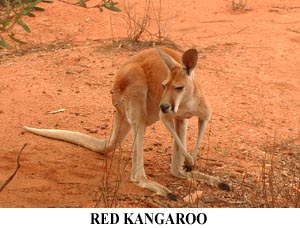
The Alice Springs resort was our headquarters for 2 nights. It was really hot when we arrived, I would guess well up into the nineties (forget this Celsius thing- I can't figure it!) But our room was cool and comfortable and we had a nice lunch by the pool. We decided to go to the Desert Park Nature Center- inspite of this intemperate weather-where I saw my first kangaroo. My first impression was like my first sighting of a moose, an animal made by committee. I know that is a mean thing to say about both critters, but they do seem ungainly. Kangaroos have little short forelegs ending in kind of claw-like fingers, huge hinged back legs for jumping, I assume, and a very long thick tail which must be used as a steering device as they zoom through the air. That night we went to an aboriginal dinner and dance where artist and promoter T. Crowe explained about aboriginal weapons, played that mournful sounding didgeridoo (what a concert that would be with a bag pipe!) and introducer four male dancers dressed in baggy red loin cloths, painted up with white paint, stunning designs on their dark brown bodies that represented hunting symbols. One dance around the campfire included audience participation. Amy bravely joined in to dance, I think, a kangaroo waltz. As did the Swiss couple who sat at our table during dinner. They were from Basle, a German speaking Swiss city. He had learned a bit of English in a six week course in Perth and had driven to Alice Springs headed for the east coast of Australia where he hoped to get a job as unemployment was at an all time low in Switzerland. Back to the dancers! My favorite was the emu dance where the four of them imitated emus, pecking on the ground, walking like emus looking around like emus, exactly like the emus we'd seen earlier at the preserve. 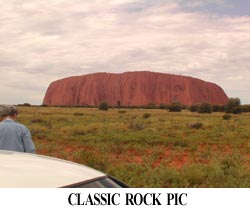
But the treat of all was the small airplane ride from Alice Springs to Uluru or Ayres Rock, the mystical symbol of the aboriginals. It is a huge monolith, a red pile of sandstone looming up in the desert. Nothing else was nearby other than a similarly colored pile of red rocks in the distance called the Olgas. A word or two about this desert. Not anything like what the word "desert" brings to mind. For in this desert there were plants and trees and grasses of every shade of green from very dark to almost yellow. Strange bottle-brush-like trees pointed skyward surrounded by purple. White and yellow flowering shrubs and bushes. One could never create such a garden; no wonder these nature people live so attached to it. 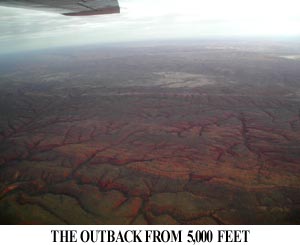
The flight up and back was fabulous. Crammed into this tiny flying machine we flew low enough to witness the most unusual terrain I've ever seen. Crusted, folded escarpments below us in shades of deep mauve, brown, red and purple; bottomless appearing fissured like valleys in between; One was where botanists discovered a rare palm tree unlike any other growing on earth. Giant, white salt lakes shone in the distance. Nothing, absolutely nothing, no evidence of human habitation stretched to the horizon, although our pilot said that sometimes-adventurous tourists travel in four-wheel drive vehicles to see the rare palm trees in "Palm Valley." 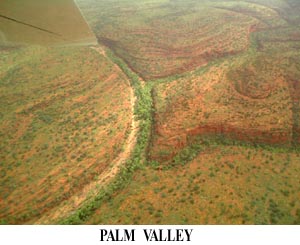
I will admit to a fascination with the aboriginal culture and thought "primitive" religions seem to be somewhat akin to each other. Native Americans, from the little that I know about same, have many similar features. Identity with the land, respect for all living things and thereby killing only what they need for food. It is about time that we "civilized" folk think about respect for one another no matter where we come from and what, if any, religious practices we adopt. I know fighting is in man's nature, but I wish we could compromise and co-operate better. We ALL live together on this lovely, little blue planet and we must learn to get along with one another. Well-enough of my Sunday sermon. It's St Paddy' Day you know! March 14 was spent mostly in the air, from Alice Springs to Melbourne to Sydney where Amy and Phil left us to pick up Stewart and drive Neville, the trusty Falcon, back to Coff's Harbour. We flew in a smallish plane to Coff's, the scene over Sydney Harbour at twilight through a thin, sun-touched cloudbank truly spectacular. We were at the Aanuka Beach resort, a place with Polynesian flair for two nights in the Honeymoon Suite! An unusual feature alongside our bed was a big, black shell-shaped spa that this Granny and Grandpa did not try. We'd get in and never be able to get out! A quick note about S/V Iwalani, berthed at the International Marina in the harbor. She shows some signs of travelling far; but down below, where Amy stewed up the best coffee I've had since arriving "down under", it's as cozy and comfortable as can be. I'm writing this from another lovely rural retreat in the green hills that are back of Coff's Harbour. We are all in a comfortable cabin together, where we had another restful night. The sound of kookaburras and other mysterious noises woke us up. But poor captain Phil complained about being kept awake all night by the cows in the pasture. Just think of them as sea cows, Phil, and you'll sleep OK! Now I'm signing off! G'day mates, it has been fun to be with y'all. Maybe someday we'll meet-somewhere. VCW March 17, 2002 Log for the week of March 24, 2002 New South Wales Australia and New Zealand by APW First of all, in keeping with the Academy Awards and thank you speeches, I'd like to take forty five seconds to thank my mother for filling in with the log for the last two weeks and to thank my Dad for the coming down under and giving Phil and me three wonderful weeks of touring and sightseeing. I think most people would balk at having to spend three weeks with their parents, but I've always been a little weird and even as a teenager enjoyed any time I could get with them. I also must apologize for no photos this week. Our brand new Nikon "Cool Pix" camera, bought at Home Zone in downtown Sydney two months ago, broke- or rather the aperture became stuck in the open position. Perhaps it is just coincidental that it happened after it went through the carry-on-luggage scan at the Alice Springs airport. It is now in the Nikon hospital in Sydney. We wrapped up the New South Wales tour with my parents back at Aanuka in Coff's Harbour. They made a trip without Phil and me, to the "Big Banana". Australia is famous for its oversized tacky fiberglass sculptures- Coff's Harbour is famous for its Big Banana. To be perfectly honest, it's not really that big. I thought the actual Big Banana was just a sign advertising the "real" big banana hidden from view. Not so. It's clearly not as impressive as the fiberglass and chicken wire Ayers Rock, which we also took my parents to see. My Dad still hadn't seen a kangaroo, either in the flesh or fiberglassed- so on Tuesday we drove over to the Coff's Harbour Zoo in search of Australia's main icon. We bumped into Danny, an Australian icon himself, who makes the "Crocodile Hunter" look like a model for an after shave commercial. He gave us the "quick tour" as we only had an hour before they closed. I actually had been leery about going to the local wildlife park- fearing it might be an exploitive, commercialized petting zoo, but was pleasantly surprised. The animals are well cared for and are happily breeding in captivity. After several photo ops with a kangaroo and joey, (the inside of the pouch does appear to be rather smarmy, not at all like the cozy handbag interior I had pictured), an echidna (the other egg laying marsupial) and lastly the koala. One of which was lying on her back in a late night TV viewing pose; all she needed was a beer can and the remote to complete the picture. I decided after much deliberation to leave Stewart at the University of Sydney Vet School Hospital, rather than take him to New Zealand. We were going to be doing a lot of flying as well as driving-and despite his being an Australian citizen, he wouldn't be able to fly with us in the cabin. He would be relegated to living in the cargo hold! I just couldn't do that to him for five seperate flights. I am afraid he was quite hissed off at me too. He thought we were headed to his favorite five star hotel- with fresh salmon delivered by room service, great views and a remote control TV. On Thursday we flew to Auckland New Zealand, leaving the Sydney airport just minutes ahead of the air traffic controller strike. This marked the end of the Australian "Amy-tour" and the beginning of the New Zealand tour arranged by my parents' travel agent in the U.S. We had a new Toyota van to tour the North Island in, instead of noisy old Neville. Perhaps it was the lack of Australian dust on the car windows, but New Zealand all of a sudden seemed shiny and clean. Even the leaves looked like an army of hobbits had polished them. The houses are neat and tidy, like neatly ironed linen napkins. In Auckland they are single story for the most part, similar to Australia, with red tiled roofs- but many have gingerbread and the slightest hint of New Caledonian architecture. Minutes from downtown Auckland were some small backyard sheep farms. In downtown Auckland large sheds housing the syndicates for next years America's cup challenge hid from view the yachts of tomorrow. The scent of curing epoxy and polyester filled the air. Grinders and sanders drowned out the tinny sounds of American pop music from the bistros and cafes lining the marina entrance. Fences capped with video cameras kept each countries high tech secrets from opposing teams. Phil and I both lamented not being here thirty years ago when the view across the America's cup village would have been of some very beautiful boats, not some sea risky pendulum-like surf boards. One can't help but compare Aussies to Kiwis. They are, after all, virtual next door neighbors down under. Both claim Russel Crowe as their own. (I guess he was born in New Zealand and owns a house in Coff's Harbour), but they are two very different places. In Australia drinking is an Olympic sport, the result is the Aussies have some pretty impressive professional grade bathrooms- well marked, well placed. The British reserve in New Zealand has made a sport out of hiding bathrooms. They can be disguised behind potted plants, framed pictures or camouflaged with wallpaper. New Zealand is really a cross between England and a South Pacific Island. Hedgerows hide each field, fields cover each hill and unfortunately, sheep (of the tourist kind) seem to be milling about the valleys, where the fluffy kind once gamboled. And yet, the addition of palm trees and Maoris give New Zealand a slightly Polynesian flavor. New Zealand was the last place the seafaring Polynesians, who were to become the Maoris, landed. There are 3.8 million people living in New Zealand vs. Australia's 20 million. Like Australia, three fourths of the population live near major cities. Tourism has replaced agricultural as the main industry. Cattle outnumber sheep, and soon, tourists will outnumber cattle. Our first real stop was Whangamata at the base of the Coromandel peninsula. Steep sided-forested hills fell to a creamy blue sea. Shoe box houses rose up behind the single main street. We spent the night at another "Heritage" listed bed and breakfast and awoke to the shaking of a logging truck rumbling down from the hills. No kookaburras. No worries of meeting up with a deadly spider in our shoe or under the toilet seat, poisonous snake in the path, or claw sharpened roo bouncing through the windshield of our lone car on the highway. It's no longer white knuckled driving. But, like the bathrooms, the New Zealanders are fond of hiding street signs. Navigation is a bit tricky. It's a down right civilized country, very beautiful as you can plainly see in "Lord of the Rings", but, it's definitely not Australia. The kiwis would say, "Thank goodness for that mate" as they look upon Aussies the way Aussies look upon Americans. It's all a bit peculiar how they spit and hiss at each other across the Tasman Sea. While on the North Island, we met up with our friends on Sunbow and Renegade. We caught up on all the gossip from the class of 2001. All juicy stuff. One American had finally fulfilled his life long goal of sailing with his wife to New Zealand. As he was tying his shoe one morning, he checked out from the planet Earth. That would be my preferred way of leaving too, no advanced notice and no sad good-byes. Another American, too busy on the radio down below- to bother with maintaining a look out while in the major New Zealand shipping lane, managed to sail his boat and family right into the side of a container ship. Fortunately for this bellicose family, the boat alone suffered the brunt of the damage. It was a pretty boat too, but is now getting a nose job at the Tauranga marina. The family is trying to figure out whom to sue for damages. I better shut up or they might come after me. The following day we drove from Whangamata via Tauranga to Rotorua. Rotorua has the most geothermal activity of any area in New Zealand. Gushing geysers, bubbling hot springs and mud pools coupled with the omnipresent stench of sulfur serve as a constant reminder that we are really just travelling through space on a molten chunk of rock. Rotorua has become the pre-eminent tourist destination in New Zealand, everyone including sheep and sheep dogs compete for tourist dollars. There are bath houses, spas, geyser tours, hikes through redwood forests where Lord of the Rings was filmed, farm tours, sheep herding demonstrations, Maori dances, hangi feasts and the latest in "Kiwi kook rides". Bungee jumping was commercialized by New Zealanders from the vine jumping that some tribes in Vanuatu invented. A Rotoruan farmer attempted to discover a method of transportation for both land and lake- and came up with Zorbing. He promptly decided that perhaps Zorbing would work better as a tourist gimmick than a farm tool. After forking out $20.00 U.S., the Zorbee is driven to the top of a hill, climbs into a huge inflated clear plastic ball and rolls down the hill. One has the choice of going "wet", (alone, or with two or three other zorbees) or alone and "dry". As it was a rather hot day, Phil and I chose the "wet form" of Zorbing. What fun it was! I almost passed out because I was laughing so hard. Our friends Paul from Renegade and Fred from Aldeberan (Milwaukee) decided to do the "dry" form. They emerged from each of their balls rather greenish colored and a bit wobbly. The crews of Iwalani, Renegade and Aldeberan also went luging- another Rotoruan tourist trap, but heaps of fun as the Aussies would say. We have a similar thing where my parents are from in Vermont called an Alpine slide. In Rotorua, the driver of these little sleds is able to steer down three choices of curvy cement tracks cut into the New Zealand hills. After an exhausting day spent playing with our friends, we caught up with my parents who had been spending the day touring the geological sights and doing more healthy cultural stuff. I almost didn't recognize my mother, who after soaking in the geothermal spa, really looked and moved around like a spring chick. We watched a Maori show- ok, but still not anything like the phenomenal Haeve dance festival in Tahiti. The Maori could really make a mint if they figured out what made my mom lose twenty years in a twenty minute sulfury soak and bottled it up for home use. Well that's it for this week. APW Log for the week of March 31, 2002 by PS South Tasman Sea No, we aren't sailing on the ocean. We are on the flight back from New Zealand. We being Amy, myself and my son Nathaniel. Nathaniel traveled halfway around the world to visit us. It means a lot to me. A whole lot. I miss both Ben and Nathaniel very much. It's been the greatest drawback to this trip. Sure, they could have come with us but, now that I have seen cruising children, I'm not sure it would have been the best option. There are lots of reasons I might go into at a later date. For now I'll just finish the log.
Monday the four of us (PS, AW, JW, and VCW) flew from Rotorua to Christchurch, which is on the South Island of New Zealand. The city was spread out on a coastal plain. There were a few multi story buildings downtown, but most of the city was parkland and trim single story houses. The city had the feeling of being older then it actually was. It was a nice change from some of the tourist towns we passed through, which seemed to have sprung up in the last twenty years. We spent the night at the Charlotte Jane, which was by far the nicest place we have stayed on our EnZed trip. From the Victorian architecture, to having the bed turned down (and mints on the pillows) before we retired for the night was all first class. Thank you, John and Chris. Our main mission in Christchurch was to meet up with the "Willy Bolton" crew. We last saw them in Apia, Western Samoa, back in September. They had dinner with us at the Charlotte Jane and we managed to catch up on news of their trip to EnZed and mutual friends. We carried out or conversation in the usual "Willy Bolton' style, everyone talking at the same time on several different topics. It's as if we are in a race to see who can exchange the most information in the least amount of time. I'm afraid we were a bit boisterous and got some cold stares from some of the other patrons. If looks could kill we each would have been dead several times over. We learned that Willy Bolton had lost its self-steering blade on the trip from Tonga to EnZed. This latest one had been custom built by Paul on Renegade. Paul had very limited resources on Tonga, but managed to build a new one from some steel pipe and sheet metal from the roof of a car. I believe this was the fourth one Willy Bolton has lost since leaving London. Willy Bolton uses an auxiliary rudder and trim tab arrangement. This type of self-steering is subject to great stress because the lower end of the rudder has no support. Our friends on Taio also have an auxiliary rudder/trim tab and the stress caused the bracing to the transom to fail. I'm not sure what the answer is except to over build it. If you think it looks strong enough, double the strength and you might have something you can use to sail around the world. We were sad to learn of the passing of one of the class of 2002. It seems this man had always dreamed of sailing to New Zealand. Shortly after realizing his dream, he died of a heart attack. He was just bending over to tie his shoe. You never know when the hand of fate will grab you. That is why Amy and I are out here. We could have waited to save up enough money to build a fancy boat or waited until Ben and Nathaniel went off to college, but we didn't. "Later" may come "Sooner" than you think. We set out the next morning for Hokitika, on the west side of the island. On the way, we stopped at the Antarctic station that is used as a staging ground for expeditions to that ice covered continent. It was a bit of a disappointment. We were hoping to learn more about the history of Antarctic exploration. Instead the exhibits were of modern explorers, a room full of ice you could slide on and an artsy film of icy scenery. The drive across the south island started out in very flat and open country. Gone were the 30-foot tall hedgerows, trimmed and neat, separating fields of various crops. Here the windbreaks were left to their own devices. Sheep now competed for grazing land and a tall mountain range loomed in the distance. As we made our way though the mountain pass, I was asked to stop repeatedly for the photographers (AW and VCW), as they couldn't resist the shapes, shadows and colors of the passing scenery. The pass opened up to an abrupt coastline of straight sand beaches along a low coastal plain. It was here, perched on top of a hill that our nights' lodging was to be found. Chris had spotted the corrugated metal, curved roofed building from the main road. Quite modern, with great views of the South Tasman Sea and the setting sun, the Kapitea Ridge certainly added variety to our trip. Over dinner that evening, Chris asked me to explain just how we update our web site. After going over all the steps, we all realized just how much we take modern communication for granted. That I should be able to communicate with the other side of the earth and exchange data in a matter of seconds still amazes me. We went into town the following morning (Wednesday) to update the web page at the local Internet café. I always look forward to getting to log posted from out of the way places. I usually learn something and this time was no exception. After explaining what I wanted to do, the owner was more than willing to let me load my FTP program onto his machine and upload the files to our site. He also let us have a look at the e-café study that was done for EnZed. It gave us some good ideas for our own café that Amy and I plan to start when we return home. Next we headed south to Franz Joseph, the site of a coastal glacier. Amy and I hiked to the face in about 30 minutes. We passed a rope barricade that warned of difficult hiking conditions about halfway down the trail. When we were within about 300 meters of the face, another sign said you needed a guide to proceed. After hiking this far, we were not about to be denied our goal. We navigated a rather rickety ladder and steep slope of solid rock to the face. A cold breeze blew down the valley and frigid water rushed out under an arch of blue glacier ice. It was hard to believe that what we were looking at actually moved. Snowfall at the top of the mountain gets so deep that it compresses into ice. The weight of the ice forces it to start sliding down the valley. The sliding creates friction that develops a layer of water. It's on this water that the ice from the top of the glacier slides to the bottom at an average rate of one meter a day. Even when the face gets shorter, the ice is still moving down the mountain. All this has a significant meaning to me because a glacier created the island I grew up on. Long Island, New York is the terminal moraine (the furthest south) of the glaciers of the last ice age. It was here that the glacier deposited its load sand and stone accumulated along its migration south. Our next stop was Queenstown, a six-hour drive further south. Once again the photographers requested frequent stops along heavily forested mountain slopes, with ferns and rain to support them. The road turned inland and the east side of the mountain range was sunny and dry. Purely by accident we came upon the pre-show practice of the Wanaka military air show. We parked along the road with dozens of other vehicles and were treated to some of the best flying I have ever seen. Mock dogfights between two P 51 Mustangs, formation aerobatics by AT-6 Texans and the sound of a radial engine powered Grumman Hellcat held us captive for over an hour. Friday we took a trip on the TSS Earnslaw, a twin screw, steam powered ferry, to a preserved sheep station on the far side of the lake. The deck on the ferry was cut open so that you could see into the engine room. The workings of the engineers and all the moving machinery of two 250 horsepower steam engines held me captive. Turning at a smooth 125 rpm, we sped along at 12 knots. What really amazed me was that the engines ran so quietly, you could have a casual conversation. Diesel engines would have been deafening. It takes one ton of coal per hour to run at full speed. That's a lot of shoveling! When we returned to Queenstown, Amy and I headed to the airport to fly back to Auckland. We needed to meet Nathaniel. John and Chris would be coming to Auckland on Saturday afternoon. After two different flights and hours of waiting, we arrived at the hotel at 10:30 PM. We must have looked a bit haggard because the desk clerk asked if we had a rough day. When we said we needed a wake up call at 4:15 AM he said "Oh dear." Nathaniel's flight was due in at 4:20 AM. We figured we would arrive at the airport by the time he cleared customs. 4:15 AM came all too soon. I didn't get much sleep, as I was worried about all kinds of things relating to changing planes and crossing half the planet. His flight arrived on time and people were clearing customs at a great rate. Eventually the airport cleared out, with no sign of Nathaniel. Parental panic set in. I headed to the service desk and asked if he was on the plane from Los Angeles. "We can't tell you." was the reply. Aggg! Now what? I had rented a Vodafone cell phone when we arrived in EnZed so that Nathaniel could all me if he had problems. I checked the phone for messages, but there were none. I dialed his number in NY to see if he was still there and was about to push the call button when he came into sight. Amy and I practically squeezed the breath right out of him! After letting him get some oxygen, we asked what the holdup was. Seems that Customs didn't care for his haircut, or should I say lack of it. After passing the sniffer dog test, they finally let him through. Sunday the three of us flew to Sydney and covered seven days of sailing in less time then one watch (4 hours). Flying is a much better way to cross the South Tasman Sea! Well, that's enough chatter for this week. PS 
|
 At ten thirty p.m. we boarded a Quantas 747-400 plus, started for Sydney, Australia- the land "Down Under" or "Oz" as it is called by some- arriving there Tuesday March 5. Where Monday went, is still a mystery, although it did seem like an unusually long, dark, night. When dawn finally began to lighten the sky, I looked down and saw nothing but navy blue water. Sometimes little fleecy clouds appeared, their edges made pink by the rising sun. And it was then that I thought of our two, alone in that very small boat probably not even a visible dot on that huge expanse of water we were so comfortably flying over. It takes guts folks- you wouldn't find me there, even in another life!
At ten thirty p.m. we boarded a Quantas 747-400 plus, started for Sydney, Australia- the land "Down Under" or "Oz" as it is called by some- arriving there Tuesday March 5. Where Monday went, is still a mystery, although it did seem like an unusually long, dark, night. When dawn finally began to lighten the sky, I looked down and saw nothing but navy blue water. Sometimes little fleecy clouds appeared, their edges made pink by the rising sun. And it was then that I thought of our two, alone in that very small boat probably not even a visible dot on that huge expanse of water we were so comfortably flying over. It takes guts folks- you wouldn't find me there, even in another life!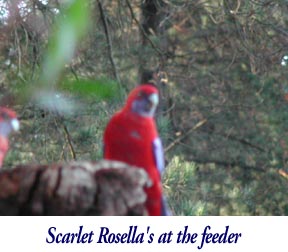 Or watch the fantastic birds come to the feeder like the big black and white magpies or red, blue and green parrots and a myriad of others large and small or even hear a kookaburra squawking.
Or watch the fantastic birds come to the feeder like the big black and white magpies or red, blue and green parrots and a myriad of others large and small or even hear a kookaburra squawking.